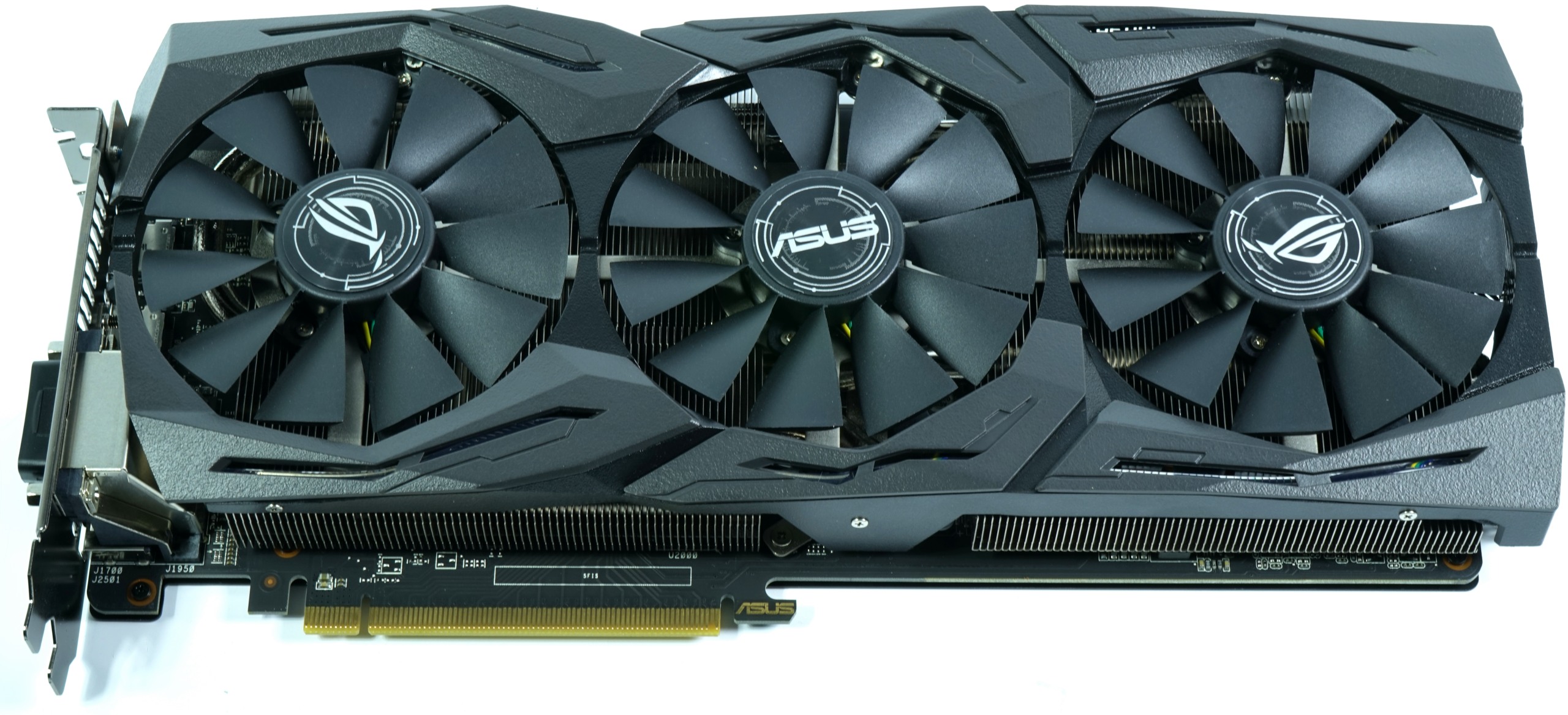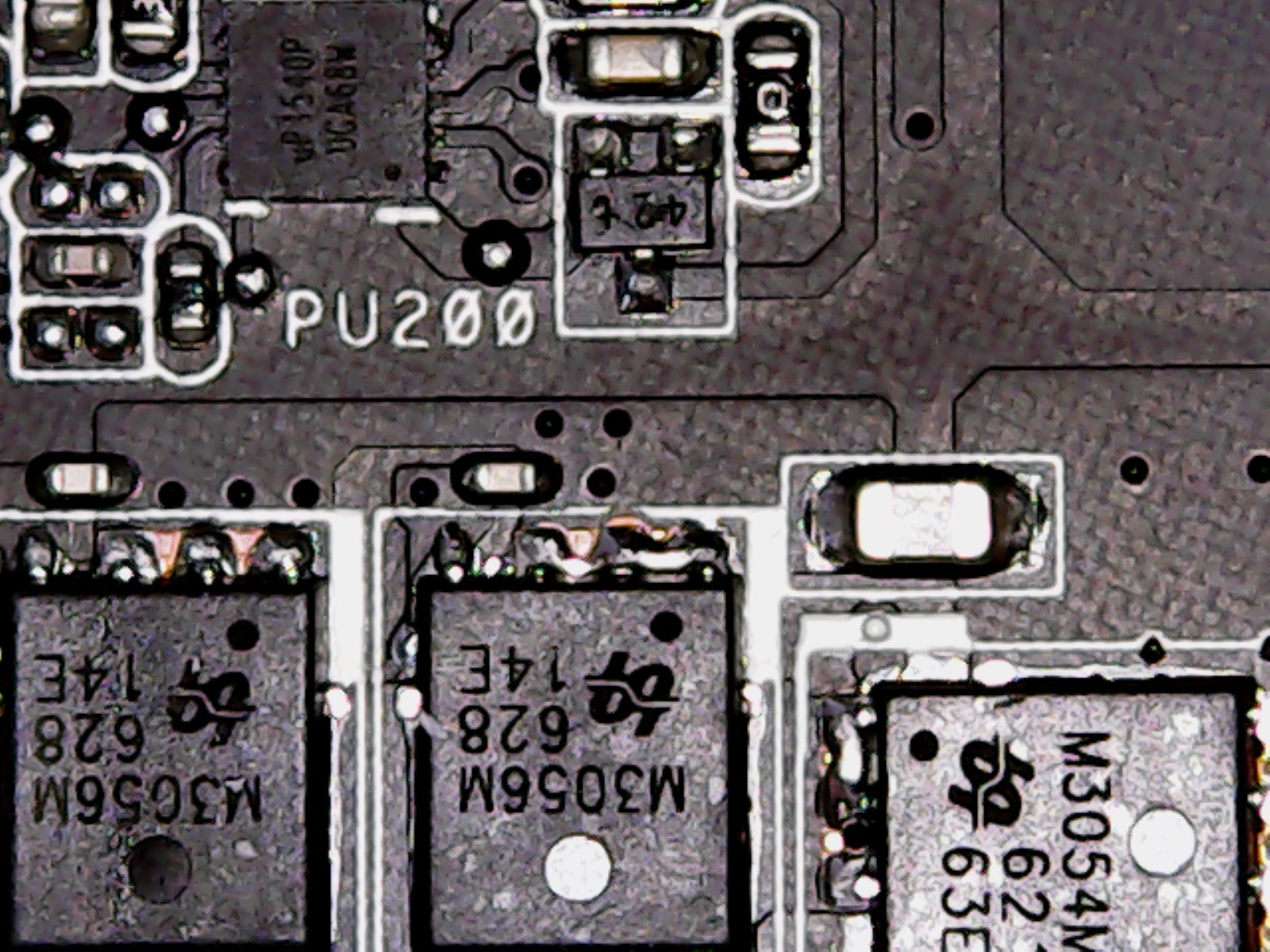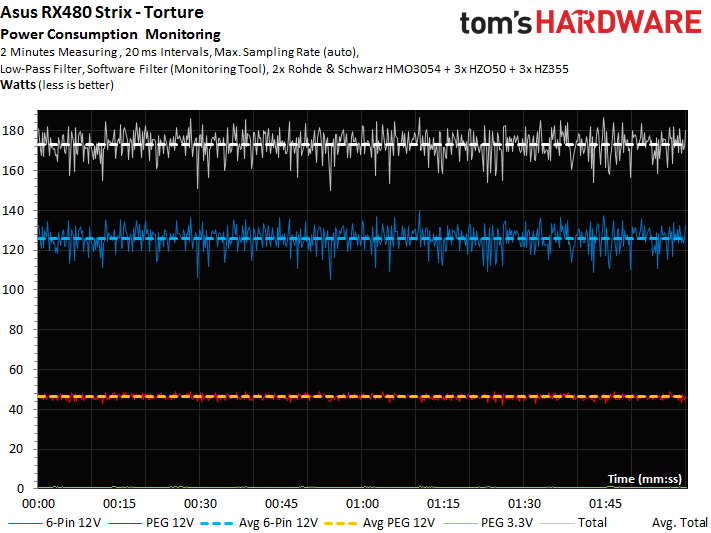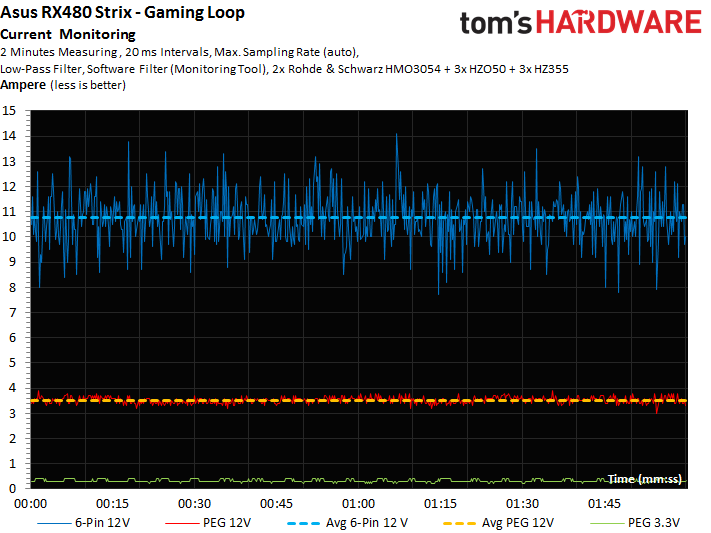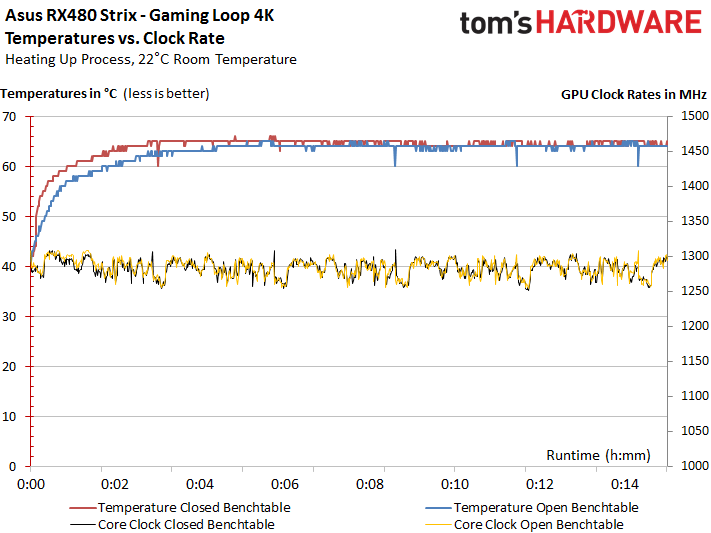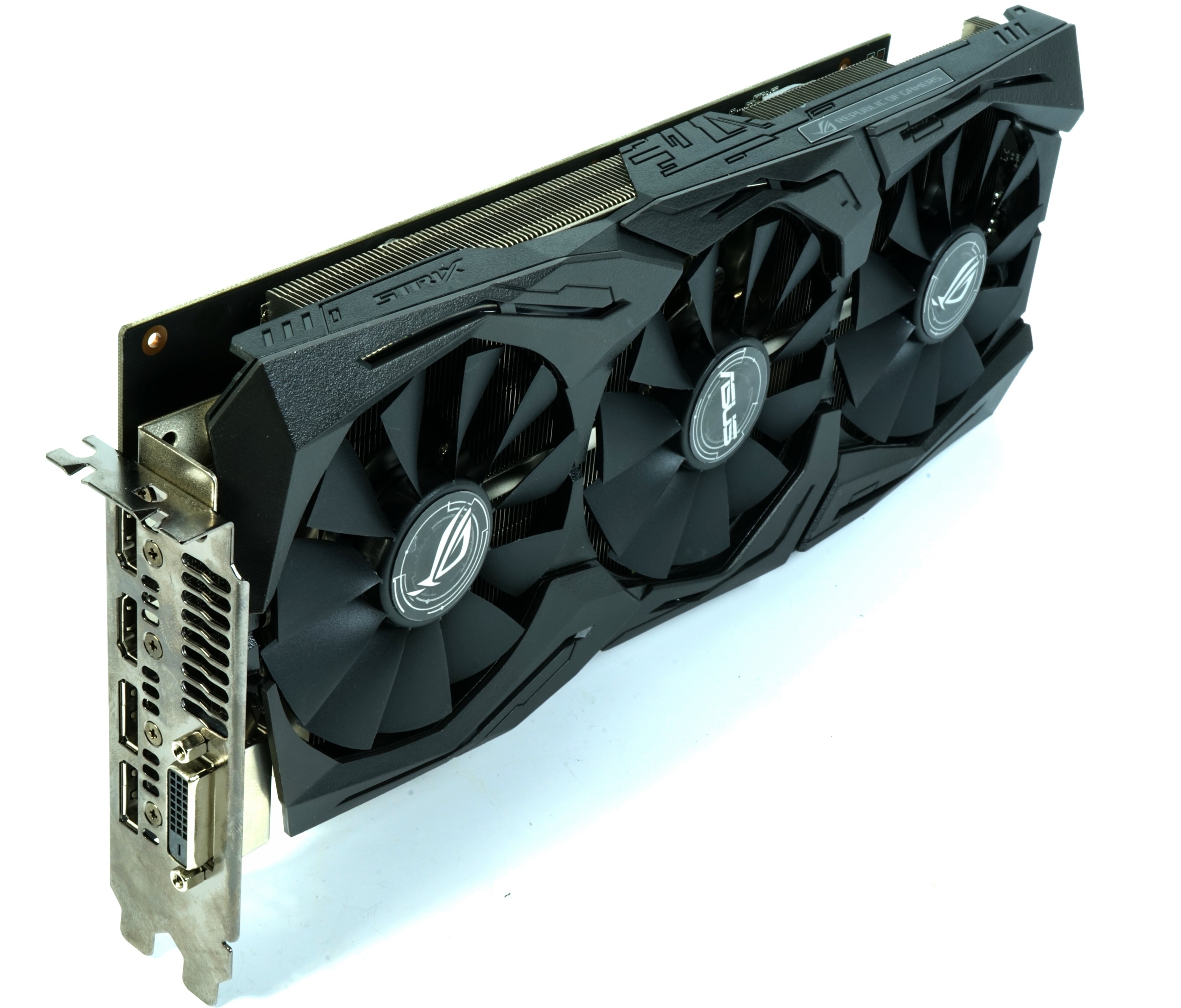AMD Radeon RX 480 Graphics Card Roundup
Asus ROG Strix RX 480
Why you can trust Tom's Hardware
Thanks to its three fans, Asus' ROG Strix RX 480 looks impressive. Moreover, we know from testing it that this board represents a well-executed compromise between performance and practicality. Unlike most other Radeon RX 480s out there, Asus really does the Ellesmere GPU justice.
A factory overclock to "only" 1310 MHz and a moderate power target make it clear the company isn't going all-out for speed. That'd only earn this card a few extra frames per second anyway. Instead, Asus sticks with its traditional strengths.
Specifications
MORE: Best Graphics Cards
MORE: Desktop GPU Performance Hierarchy Table
MORE: All Graphics Content
Exterior & Interfaces
Weighing in at 36.7 oz (1041 grams), the ROG Strix RX 480 is distinctly heavy. It also qualifies as a dual-slot solution at 30cm long, 12.6cm tall, and 3.5cm wide. Still, though, those dimensions could spell trouble in small enclosures, particularly due to the card's length. Because of the backplate, you must plan for an additional one-fifth of an inch (5mm) of clearance to avoid collisions with your CPU's cooler, again complicating installations in compact cases.
Visually, the card employs a typical Strix design with an LED-lit logo as part of its backplate. Enthusiasts with windowed cases and an affinity for flashiness will appreciate the eye candy, to be sure.


The cooler cover is made of plastic. In our opinion, it looks alright. At least the shroud feels strong enough, given the card's heft. Three 8.5cm fans push plenty of air through the heat sink, even at relatively low speeds. Given the thermal solution's relatively low profile, a lot of static pressure isn't really needed anyway.
Asus' DirectCU III cooler employs vertically oriented fins, which makes sense for a three-fan design. The top of the card features an eight-pin auxiliary power connector. Other than that, it's as unremarkable as the bottom. If you want to see more of the actual cooler, you'll have to remove the shroud. Challenge: accepted.
At its end, the card features two PWM-controlled fan headers. These could be used to connect a pair of case fans that are only activated if high temperatures are detected. While that'd be a good idea, most cases unfortunately only have three-pin voltage-controlled fans installed up front. These won't work. Worse, Asus neglects to mention the maximum load the headers accommodate.


The slot bracket is loaded with outputs. You get one DVI-D port, two DisplayPort 1.4-ready connectors, and a pair of HDMI 2.0 interfaces. This doesn't leave a ton of room on the bracket, but Asus does find space for a number of cut-outs. Theoretically, these would help exhaust waste heat. Because the heat sink's fins run vertically, though, the holes serve no real purpose.
Board & Components
With the backplate, stabilization frame, and cooler removed, we get a better look at the PCA. Asus places the voltage regulation circuitry for the GPU and memory on the right side, leaving the left almost completely empty.
Like AMD, Asus uses eight Samsung GDDR5 memory modules (model number K4G80325FB-HC25). Each one has a capacity of 8Gb (32x 256Mb). And depending on clock rate, they can operate at voltages between 1.305V and 1.597V. Their ceiling is 2000 MHz, similar to what we find on Nvidia's GeForce GTX 1070.


The GPU is fed by six phases provided by an International Rectifier ASP1300. What makes this programmable PWM controller special are its overclocking capabilities. Using the SMBus, an extensive command set can be utilized, including access to a VID of up to 2.3V. Features like a freely configurable maximum voltage, VID override, individual load-line calibration, and OVP/OTP stand out as unique compared to what we normally have access to.
International Rectifier's IR3555 is a good match, containing a buck gate driver IC co-packed with control and synchronous MOSFETs, plus a Schottky diode.


Asus relies on its in-house Super Alloy Power feature to describe the chokes and capacitors, which it says facilitate cooler operation and a longer life expectancy. Of course, we can test for temperature, but don't have a metric for capacitor longevity yet.

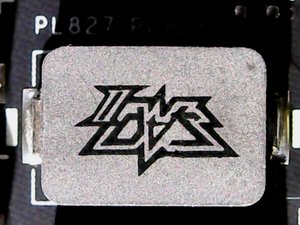
In contrast, the memory's single power phase is a more conservative choice. A second, seemingly similar voltage converter provides power for peripherals and controllers; it features a somewhat simpler smoothing.
Here, Asus uses the uP1540 as a PWM controller. For each of the two phases, it controls one QM3054 (30V, 4.8mΩ, 97A) N-channel MOSFET on the high side and two QM3056 (30V, 4.2mΩ, 103A) N-channel MOSFETs on the low side.
Power Results
The almost 20W idle result doesn't impress us, but we can see it's caused by rather generous voltage settings and a high frequency of 300 MHz. Hopefully, AMD improves this behavior in its next generation of graphics cards.
During our gaming loop, the ROG Strix RX 480 consumes approximately 175W. That's only moderately higher then what we saw from the reference design. Meanwhile, our stress test reports 173W, which is imposed by a 180W power limit.
We mention short load peaks only as a side note (see the light-grey bar in the chart below), since they're rarely relevant in practice. Nevertheless, they illustrate the importance of deploying a reasonably-sized secondary side for the power supply (low-impedance caps).
The following two graphs represent two minutes captured from the gaming loop and stress test. These are what our average power consumption figures are calculated from.
The next two graphs map current measurements at each of the supply rails, corresponding to the power consumption levels shown in the diagrams above.
Unlike some of the other cards we're looking at in today's round-up, these results should put your mind at ease. A total of just 3.8A is comfortably low compared to the allowed 5.5A. Only the memory's power comes from the motherboard slot; the GPU's six phases get their power from an eight-pin auxiliary connector.
Temperature Results
Asus' cooler is fairly conservative, consisting of a heat sink, frame, and backplate.
Only the frame helps draw heat away from the memory. Unfortunately, its coverage of the modules is partial. Whether or not that's ample remains to be seen. At least the memory also receives some airflow from the fans.
Lacking thermal pads, the backplate doesn't help with cooling. As mentioned, though, the plate's back side does sport an LED for illuminating the logo.
The cooler itself consists of two parts. The larger piece is positioned atop a solid block of aluminum that holds one 6mm and four 8mm nickel-plated heat pipes. The latter are flattened over the GPU for better contact.
We do like that the VRM heat sink is built into the cooler, leveraging its large array of fins. Asus could have done better, though, with a multi-level solution touching the chokes as well.
Either way, the thermal performance we observe is superb. As the auto enthusiast saying goes, there's no replacement for displacement, or in this case heat sink surface area. With a maximum of 149°F (65°C) in a closed case and 147°F (64°C) on an open test bench, the GPU stays nice and cool, even during our stress test. The clock rate does drop a bit, but that's related to Asus' power limit and not the processor's temperature.
Still, an average of 1280 MHz is pretty good. At this same point, competing cards consume up to 50W more for an extra 50 MHz. That small of a gain in the face of much higher power use just doesn't make sense.
Remember when we mentioned that Asus' frame only partially covers the memory? On our test bench, those modules heat up to about 176°F (80°C), while in a closed case the temperature stays just below 181°F (83°C). Although this is still within Samsung's specs, a larger frame would have helped ensure better results.
Topping out at 183°F (84°C), the voltage regulation circuitry has headroom to spare.
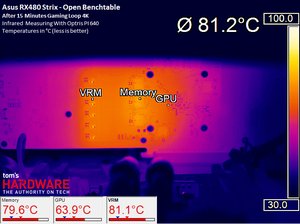

A maximum value of 183°F (84°C) in a closed case shows the hottest module right at the limit of what's acceptable. This probably isn't a dire situation, though. After all, we're deliberately invoking a worst-case scenario. A real-world workload won't look as bad.


Asus' DirectCU III cooler shows that it's generally possible to ensure roughly the same temperatures, regardless of whether you're measuring on an open test bench or in a closed case. This becomes an advantage for Asus as we test competing cards that start gasping for cool air in an enclosed environment.
Sound Results
But how does the company go about achieving nearly identical temperatures in our gaming loop and stress test, regardless of whether its card is on an open chassis or in a closed case? A look at the fan speeds reveals they (unsurprisingly) went from 500 to 600 RPM when we buttoned everything up into an enclosure. You might consider that to be problematic. However, it looks like this behavior is by design.
An outstanding measurement of 37.8 dB(A) under a gaming load sets the bar high for competing cards, especially since our readings are even lower on an open test bench. The noise generated is almost free of the low-frequency peaks you'd hear from poorly-manufactured fan bearings. Coil whine is almost non-existent, too. Instead, the noises integrate well together, yielding an acoustic work of art.
By deliberately not trying to get every last bit of frequency out of Ellesmere, Asus came up with a well-cooled card that also operates quietly. It doesn't matter if you use the ROG Strix RX 480 on an open test bench or inside of a closed case, the readings we recorded are just right.
In comparison to the most aggressively tuned competition, Asus loses out by a couple of frames per second at worst, despite its conservative power consumption. But the performance loss isn't noticeable in practice.
What you will notice is the subtle fan work that results in a pleasant-sounding card. Perhaps the worst thing we can hold against the ROG Strix RX 480 is its length. Smaller cases may have a difficult time accommodating such a long fan shroud. Of course, you also need to be alright paying ~$240 for an 8GB Radeon RX 480. With that said, if you're dead set on Polaris, Asus' card is one of the top options out there.
In our opinion, this is the only RX 480 worthy of an Editor's Choice award thanks to its successful balance of efficiency, gaming performance, and cooling. There are faster cards in our test field, but none of them combine the other qualities we consider to be important.
Asus RX 480 Strix
Reasons to buy
Reasons to avoid

MORE: Nvidia GeForce GTX 1080 Roundup
MORE: Nvidia GeForce GTX 1070 Roundup
MORE: Nvidia GeForce GTX 1060 Roundup
Current page: Asus ROG Strix RX 480
Prev Page Reference AMD Radeon RX 480 Next Page HIS RX 480 IceQ X² Roaring TurboGet Tom's Hardware's best news and in-depth reviews, straight to your inbox.

Igor Wallossek wrote a wide variety of hardware articles for Tom's Hardware, with a strong focus on technical analysis and in-depth reviews. His contributions have spanned a broad spectrum of PC components, including GPUs, CPUs, workstations, and PC builds. His insightful articles provide readers with detailed knowledge to make informed decisions in the ever-evolving tech landscape
-
alchemy69 Not sure where you found a reference card for $180 but it sure as Hell wasn't Amazon.Reply -
artk2219 You can find them on Newegg for around that much pretty often. Also the R9 Fury is a hell of a mixed bag, Some games its matching a 1070, others its below the 480. Weird.Reply -
techy1966 I only ask because I have 2 390x cards and I get way better results than yours does here and yes with crossfire off mine is getting better results granted it is overclocked @1236mhz. Heck I just played watch dog 2 single card mode and got always above 60 fps here that card is getting 45 fps..just saying is all. Nice write up though. Just noticed GTA numbers as well and was WTH why is their 390x card sucking so much must be old old drivers I 'm sorry but even with crossfire off my numbers at 1080p are way higher maxed out. I do know I can beat a 480 in everything and slaughter it in crossfire will Vega ever get here already or do I have to slide over to the green team lol.Reply -
shrapnel_indie HIS has been missing from the U.S. Market for a few years now. As to noise, Yes we can measure it, and determine a loudness level, but tolerance is dependent on the individual as always. I still question the price links used as some are unrealistically high compared to the market Amazon competes in (Mail-Order.)Reply
Was the latest driver used? Was the BIOS updated in every card? -
digitalgriffin I am a bit perplexed as to why you love the ASUS Strix so much with a 6 pin power connector. Either it's pulling too much power over the PEG, or pulling too much power over the 6 pin. It really needs an 8 pin connector to stay in spec.Reply -
blppt "Also the R9 Fury is a hell of a mixed bag, Some games its matching a 1070, others its below the 480. Weird."Reply
The newest generation AMD cards (Polaris) are apparently designed to handle heavy Tessellation better than previous gens, so my guess is that would be the circumstances in which the RX480 beats the Fury. I would say it was the extra 4GB of frame buffer space, but we've seen that the HBM often negates that RAM shortage in many benchmarks. -
NewbieGeek Hmm. Interesting article. Personally never had temperature issues with my Sapphire Nitro rx 480 8gb. Maybe Tom's is defective? Mine runs at 1330mhz core 2020mhz ram without drops, even during intense gaming... And I've got a custom fan curve making the card quieter than stock...Reply
